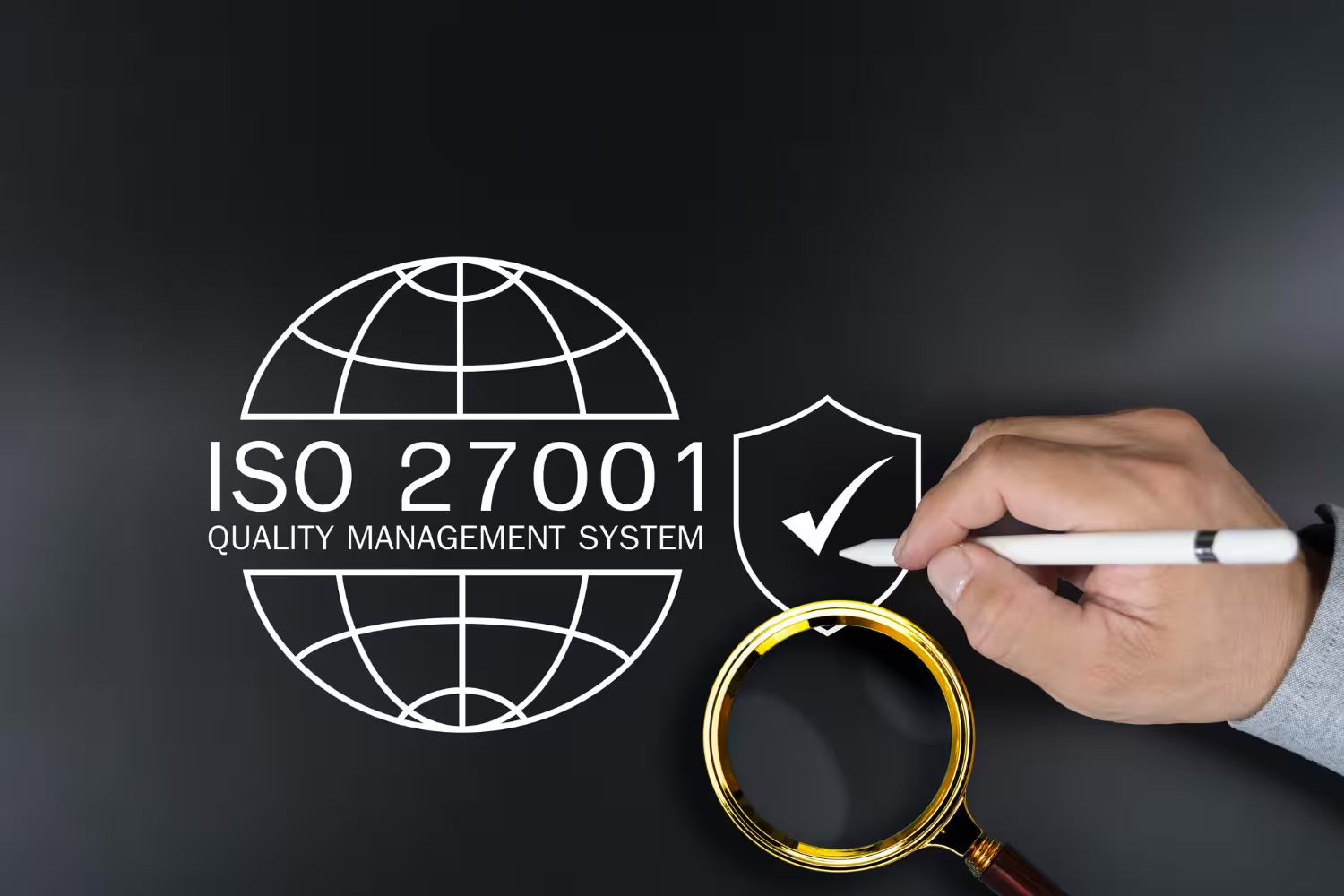[ANSWERED] What is a GRC Tool?
Let’s dive in and find out exactly what GRC is, the benefits of implementing it into your daily operations, and the challenges associated with it.

In 2023, security breaches cost businesses around $220,000 more when noncompliance with regulations was a factor.
Governance, risk, and compliance can no longer be an afterthought. The costs associated with failing to meet regulatory standards are far too great.
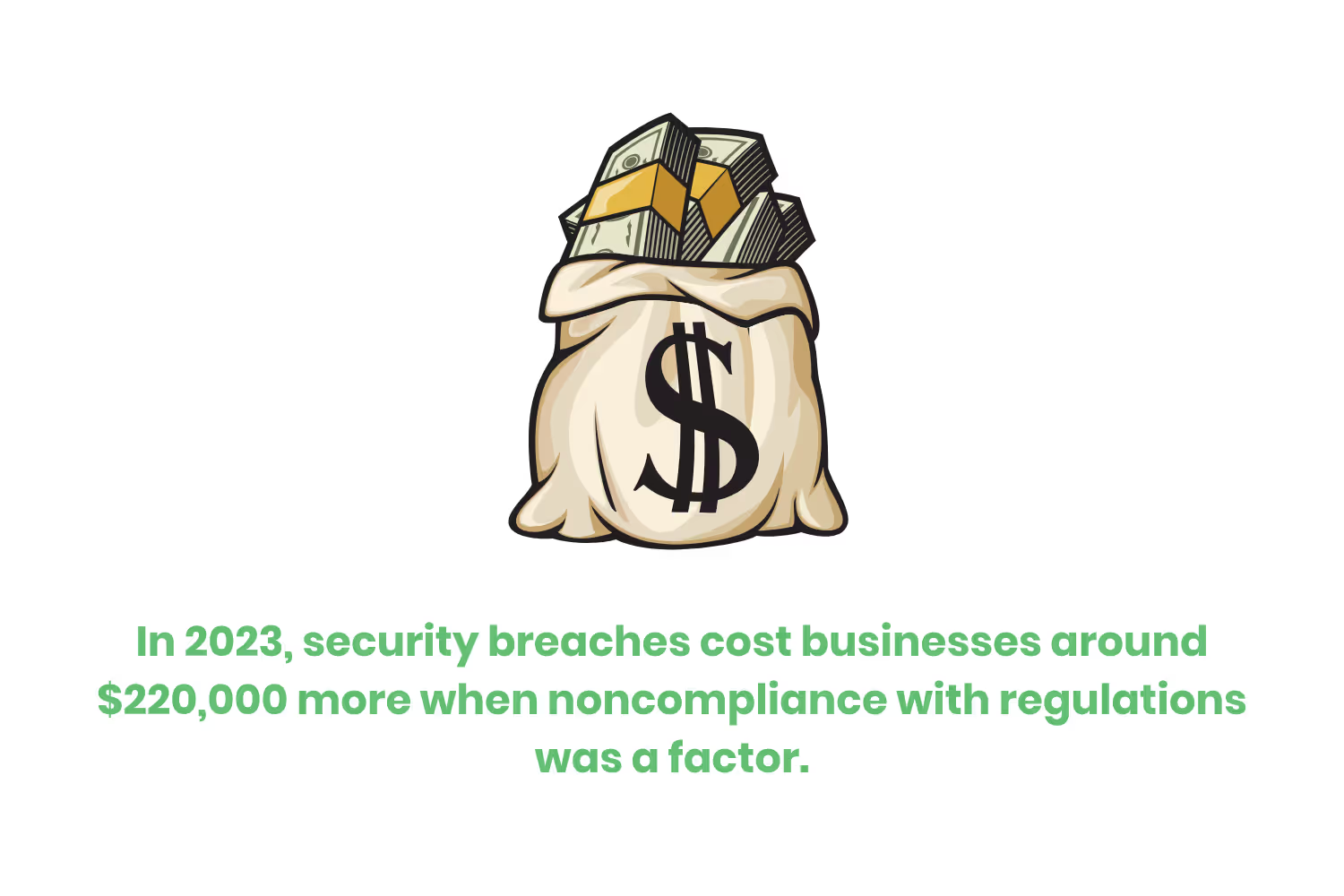
You’re looking at not only financial loss but reputational damage as well. Even hefty legal repercussions can rear their ugly head in a situation like that.
That is why Governance, Risk, and Compliance (GRC) is so important in today’s professional climate. Incorporating these policies helps to establish a safeguard for your organization against these potential threats.
Let’s dive in and find out exactly what GRC is, the benefits of implementing it into your daily operations, and the challenges associated with it.
What is GRC?
GRC programs help align companies’ business goals with IT prerogatives. All while managing any potential security risks.
It also ensures that companies meet whatever industry and government standards are necessary. Included in GRC programs are tools and processes that help to unify your organization through technological innovation.

Organizing goals and removing uncertainty aren’t the only benefits of a GRC tool. Meeting compliance requirements through these processes also offers a sort of safeguard even in times of security breaches. Having the ability to show you did take steps toward being compliant is critical during an audit.
A good GRC tool effortlessly combines governance, risk management, and compliance in one model. Let’s go over each of the pillars of GRC separately to see just how important each one is.
Governance
Governance is the first pillar of the acronym, so let’s start there. It covers the set of policies and rules that companies use to achieve business goals. Also, the set of frameworks appropriate to achieve those goals. Governance helps to define any responsibilities of stakeholders. This can include the board of directors or even senior management.
Good governance includes but is not limited to:
- Transparent sharing of data and information.
- Accountability (as well as ethics).
- Policies covering conflict resolution.
- Resource management and more.
Maintaining alignment with government requirements is important. After all, corporations paid out over $1 trillion in penalties for U.S. regulatory infractions by April of 2024 alone.
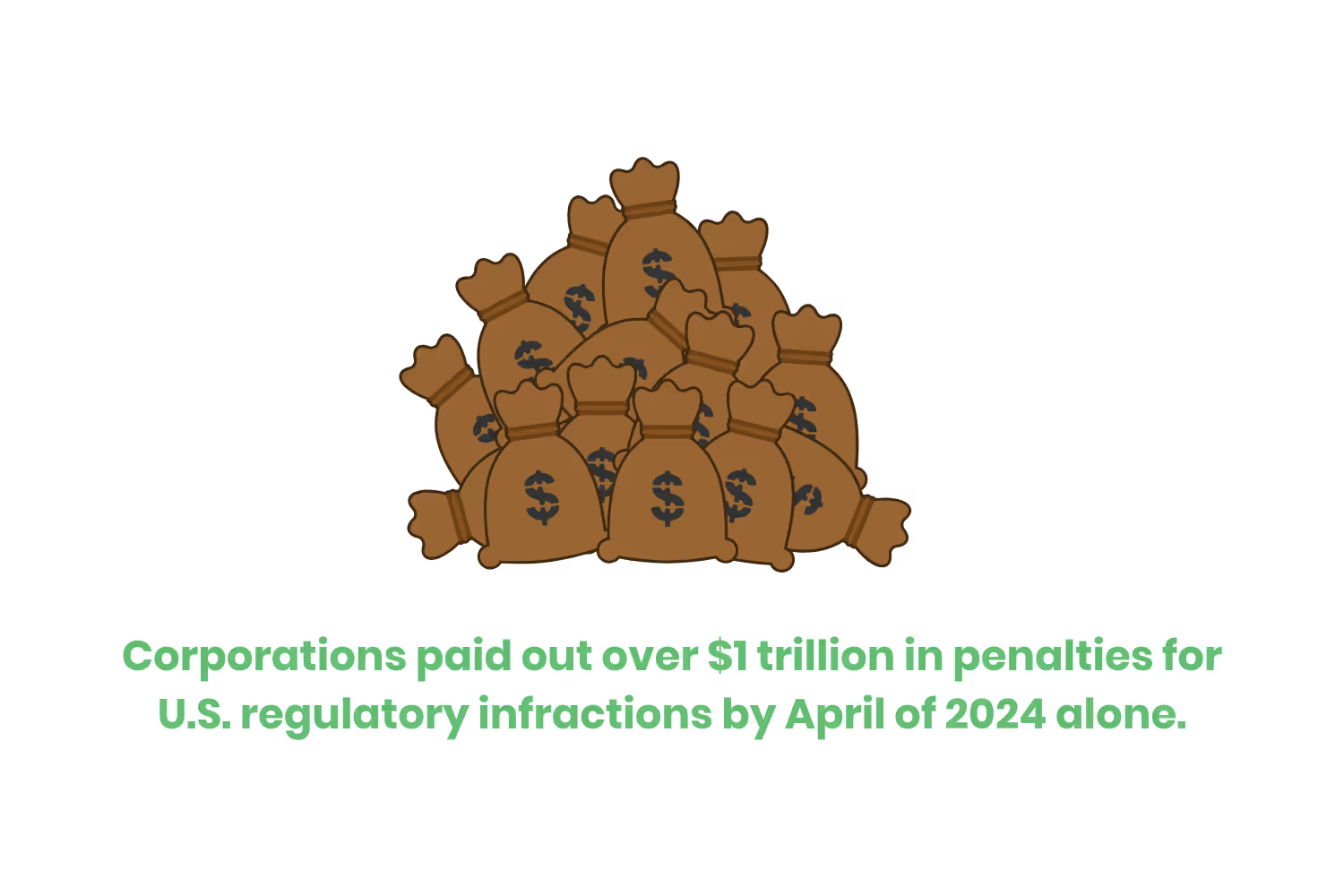
Risk Management
Next, we have the ‘R’ of GRC, risk management. The truth is that only 6% of directors believe their organization's board is effective at managing risk.
There are different kinds of risks businesses face. Some are more common depending on the industry the company serves.

Some examples of these common types of risks include:
- Financial risks.
- Legal risks.
- Strategic risks.
- Security risks.
If you invest in proper risk management, you can rest assured you will be able to more easily identify risks before they become an issue. Not only can you find them promptly, but remediate them, as well. Avoiding costly mistakes altogether.
Compliance
Finally, we arrive at the last piece of the puzzle: compliance. To put it simply, this section of the GRC formula focuses on following rules.
Any laws and regulations that apply to your industry get covered under this pillar, making sure you and your team adhere to them. Government and industrial bodies require companies to implement procedures in order to ensure compliance with these regulations.
The Benefits of Integrating a GRC Program
So why is it important to have a GRC tool? Studies show that effective GRC instantly reduces compliance costs by as much as $3 million dollars.
From the information above, I’m sure you can come up with your answer. But while I have you here, let me list out a few of the main reasons you don’t want to skip out on this helpful tool.
Having a GRC program in place helps unite an entire company under the same policies, decisions, and actions. Businesses as a whole are therefore better able to navigate risk-aware environments using GRC the tools for making data-driven decisions. Allowing you to make faster and safer choices.
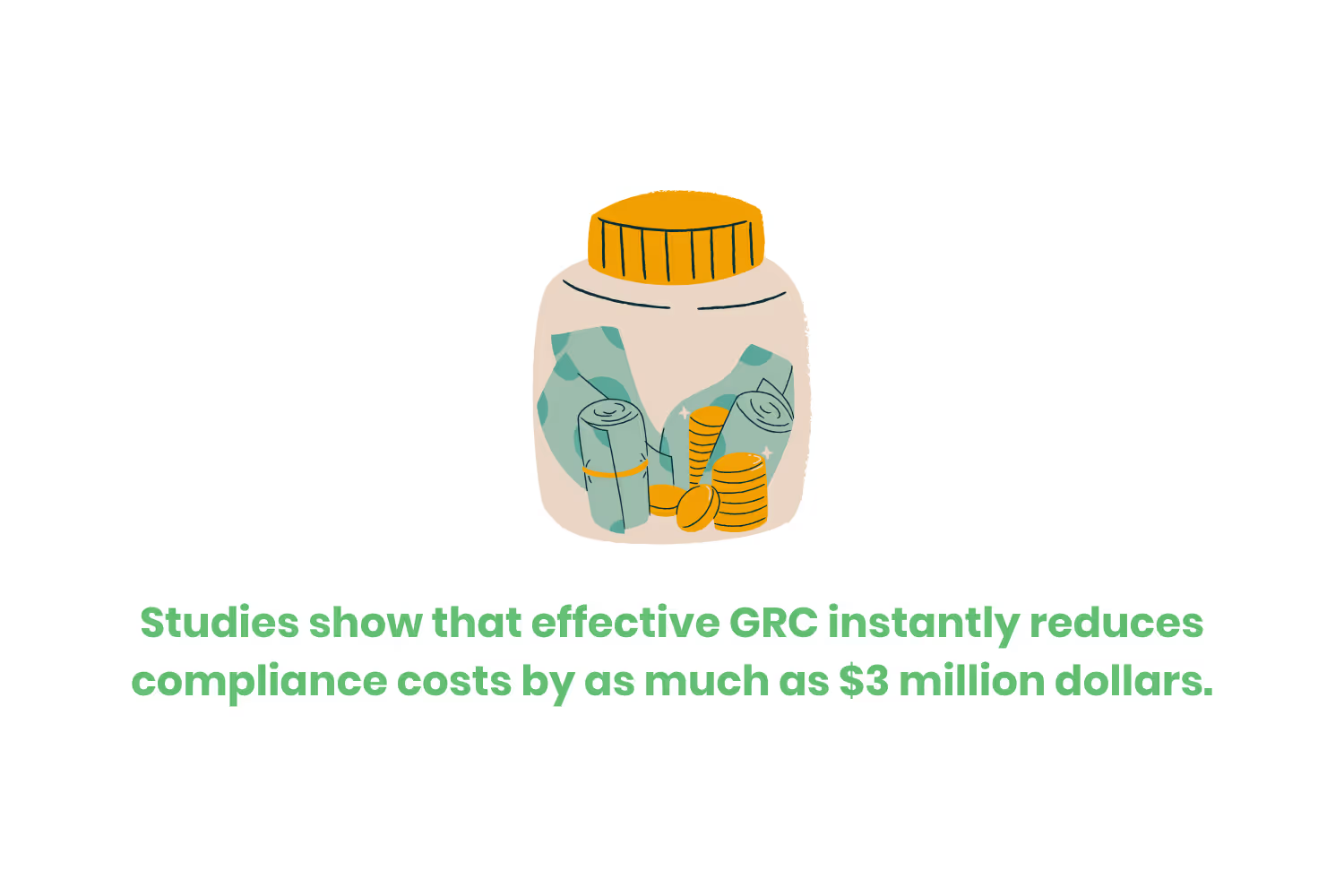
Streamlining your organizations’ around a common company culture that promotes ethical values is another benefit. GRC operations can help guide your team to develop and grow as a unit through shared ethical-decision making processes.
Finally, let’s talk about the benefit of improved cybersecurity through incorporating GRC practices. Employing data security measures as implemented by your integrated GRC program helps to protect your private information. As well as any customer data you deal with on a daily basis. Even as the risk of cybersecurity breaches rises every day, making sure you can comply with current data and privacy regulations will help keep your organization safe.
How Does GRC Work?
GRC procedures may differ slightly from company to company, but there are a few principles every team needs to incorporate into their system. For instance, there must be cross-functional collaboration between departments.
Here are some examples of departments included, and their importance to the system:
- Senior executives: These executives assess risks while making decisions.
- Legal teams: These employees can help businesses mitigate any legal issues.
- Finance managers: These managers help support compliance efforts by completing regulatory requirements.
- Human resource executives: These team members deal with confidential employee information.
- IT department: Protects data from both inside and outside cyber threats.
Another “must have” is adopting the correct “GRC framework”. These frameworks are models for managing governance and risk. They help identify key policies that align with your company’s strategic objectives, so you can more easily reach your professional goals.

Key stakeholders can then better:
- Devise policies.
- Structure workflows.
- Govern the company.
Through having a well-planned governance, risk assessment, and compliance strategy, you can reach a high GRC maturity level. Having a high GRC maturity level results in:
- Cost efficiency.
- Productivity.
- Effectiveness in risk mitigation.
To help coordinate and monitor the success of the GRC framework and maturity levels, companies will sometimes use software and other tools.
Common GRC Tools
To help coordinate and monitor the success of a company’s framework, they will use GRC software and other tools. This software is helpful while overseeing policies, assessing risk, and continuing to ensure compliance.
The software can also help perform the following tasks:
- Keep your organization updated on various regulatory changes that affect business.
- Enables multiple business units to collaborate on the same platform.
- Assist with internal audit processes.
- User management software keeps access to important data secure.
You can also use security information and event management (SIEM) software to detect potential cybersecurity threats. Using these applications and tools can help you improve your organization’s efficiency while reducing costs.
When talking about GRC tools it is important to include the GRC Capability Model. This model houses guidelines that help your organization implement GRC procedures.
Tips on GRC Implementation
Even though there are massive amounts of instant revenue savings associated with implementing a GRC tool, many companies still haven’t implemented one.
The reality is that only 69% of organizations are leveraging technology to support their compliance initiatives.
When implementing your GRC model, there are a few main things you need to focus on. First, be sure to define clear goals. Determine what you want to accomplish with your GRC model. Next, assess your existing procedures. Doing this helps bring different parts of your organization into a more unified framework. Include any current processes and technologies that handle governance, risk, and compliance.
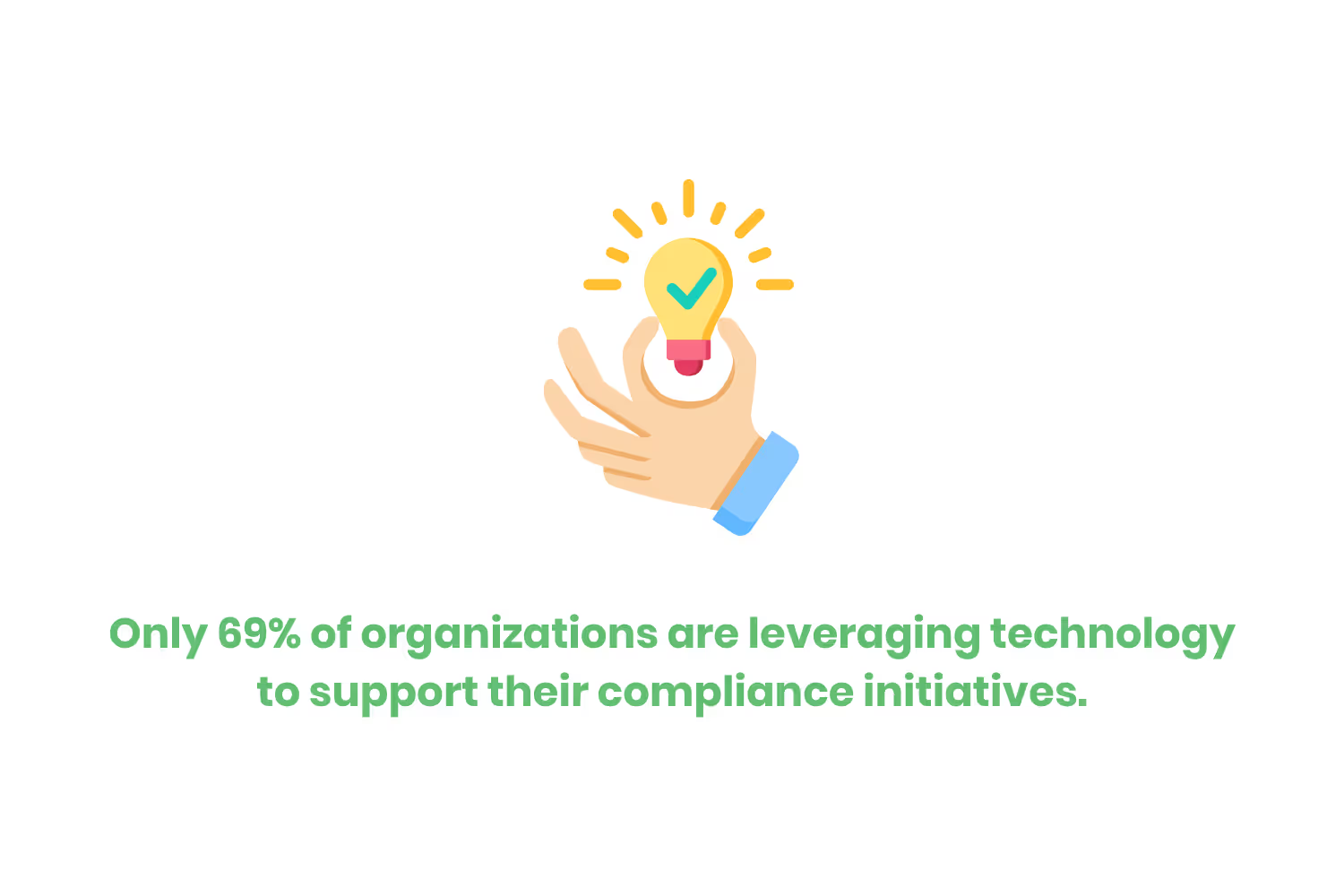
Be sure that everyone on your team understands and adheres to the GRC program. This includes senior executives and management. When leaders set clear expectations on GRC-driven policies, this encourages more acceptance within the company as a whole. Thus, making it easier to implement them. There should also be clear roles and responsibilities for each employee set at this time. This fosters accountability and allows for prompt action as everyone will know what role they play.
Use software and other GRC solutions to help manage your program. You can also use these tools to help monitor and record your processes and resources. As well as monitor your regulatory compliance requirements.
Test your GRC framework before implementing it in the entire company. You can use this as a “trial and error” time to make sure that your specific framework aligns with your goals. Small-scale testing allows you to find and fix any bugs before they become full-blown company-wide issues.
Challenges with GRC Implementation
So we’ve gone over quite a lot of information. We have a better idea of what GRC is, know the benefits, and have some handy tips on how to incorporate a new framework if needed. But what about the challenges associated with GRC programs? Well, as with anything, there are a few tribulations that come with implementing your GRC program.
Let’s take a look at a few of them now, and briefly discuss:
- Change management: As regulations and governance policies change, you need to be sure to have a way to seamlessly incorporate new policies and procedures. In the fast-changing business environment, keeping compliant through these transitions is a challenge. Because of this, we suggest setting up a change management program.
- Data management: Duplicate data can be a problem when different departments generate and store information in the same framework.
- Lack of a total GRC framework: Without a total GRC framework, your implementation will likely yield a fragmented and ineffective program. Be sure to have your framework integrate all business activities with your GRC components.
- Ethical culture development: Having every employee in a company adhere to an ethically compliant culture is a challenge. This is why starting from the top, with executives setting a good example, is key.
Conclusion
At the end of the day, companies face all sorts of challenges that can endanger not only their bottom line but their reputation as well. These include keeping up with new regulatory requirements, risk management, and staying on top of data privacy (to name a few). That’s why GRC tools are critical in today’s evolving landscape.
By using the correct tools, setting clear goals, and choosing the right framework, GRC programs can turn any potential obstacles into opportunities for growth. It is widely understood in today’s professional climate that the benefits of this tool far outweigh any costs associated!
Emphasize your product's unique features or benefits to differentiate it from competitors
In nec dictum adipiscing pharetra enim etiam scelerisque dolor purus ipsum egestas cursus vulputate arcu egestas ut eu sed mollis consectetur mattis pharetra curabitur et maecenas in mattis fames consectetur ipsum quis risus mauris aliquam ornare nisl purus at ipsum nulla accumsan consectetur vestibulum suspendisse aliquam condimentum scelerisque lacinia pellentesque vestibulum condimentum turpis ligula pharetra dictum sapien facilisis sapien at sagittis et cursus congue.
- Pharetra curabitur et maecenas in mattis fames consectetur ipsum quis risus.
- Justo urna nisi auctor consequat consectetur dolor lectus blandit.
- Eget egestas volutpat lacinia vestibulum vitae mattis hendrerit.
- Ornare elit odio tellus orci bibendum dictum id sem congue enim amet diam.
Incorporate statistics or specific numbers to highlight the effectiveness or popularity of your offering
Convallis pellentesque ullamcorper sapien sed tristique fermentum proin amet quam tincidunt feugiat vitae neque quisque odio ut pellentesque ac mauris eget lectus. Pretium arcu turpis lacus sapien sit at eu sapien duis magna nunc nibh nam non ut nibh ultrices ultrices elementum egestas enim nisl sed cursus pellentesque sit dignissim enim euismod sit et convallis sed pelis viverra quam at nisl sit pharetra enim nisl nec vestibulum posuere in volutpat sed blandit neque risus.

Use time-sensitive language to encourage immediate action, such as "Limited Time Offer
Feugiat vitae neque quisque odio ut pellentesque ac mauris eget lectus. Pretium arcu turpis lacus sapien sit at eu sapien duis magna nunc nibh nam non ut nibh ultrices ultrices elementum egestas enim nisl sed cursus pellentesque sit dignissim enim euismod sit et convallis sed pelis viverra quam at nisl sit pharetra enim nisl nec vestibulum posuere in volutpat sed blandit neque risus.
- Pharetra curabitur et maecenas in mattis fames consectetur ipsum quis risus.
- Justo urna nisi auctor consequat consectetur dolor lectus blandit.
- Eget egestas volutpat lacinia vestibulum vitae mattis hendrerit.
- Ornare elit odio tellus orci bibendum dictum id sem congue enim amet diam.
Address customer pain points directly by showing how your product solves their problems
Feugiat vitae neque quisque odio ut pellentesque ac mauris eget lectus. Pretium arcu turpis lacus sapien sit at eu sapien duis magna nunc nibh nam non ut nibh ultrices ultrices elementum egestas enim nisl sed cursus pellentesque sit dignissim enim euismod sit et convallis sed pelis viverra quam at nisl sit pharetra enim nisl nec vestibulum posuere in volutpat sed blandit neque risus.
Vel etiam vel amet aenean eget in habitasse nunc duis tellus sem turpis risus aliquam ac volutpat tellus eu faucibus ullamcorper.
Tailor titles to your ideal customer segment using phrases like "Designed for Busy Professionals
Sed pretium id nibh id sit felis vitae volutpat volutpat adipiscing at sodales neque lectus mi phasellus commodo at elit suspendisse ornare faucibus lectus purus viverra in nec aliquet commodo et sed sed nisi tempor mi pellentesque arcu viverra pretium duis enim vulputate dignissim etiam ultrices vitae neque urna proin nibh diam turpis augue lacus.


